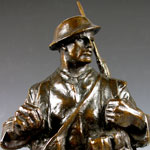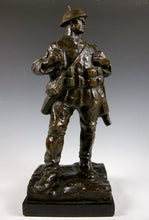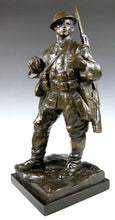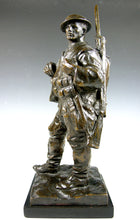Height 46cm (14ins)
The present figure is modelled as a British infantryman heavily equipped for trench duty during the winter months. He wears a Brodie Helmet (introduced 1915), a standard issue leather jerkin and trench waders issued to soldiers working in deep water and mud. His equipment comprises modified 1908 Battle Order, with webbing, haversacks, valise, mess tin and entrenching tool helve clearly discernible. His Short Magazine Lee Enfield .303 calibre rifle with bayonet fixed is slung from his left shoulder. He stands in confident pose with thumbs tucked into rifle sling and webbing, expressing a calm workmanlike authority amidst the mentally and physically testing conditions of the trenches that the sculptor knew firsthand.
William McMillan, R.A., C.V.O.
Read more
Born in Aberdeen, McMillan, was the son of a master engraver and printer, and received his early professional training at Aberdeen’s Gray's Art School before attending the Royal College of Art where the creator of the Royal Artillery Memorial at Hyde Park Corner C.S. Jagger was also a student. McMillan also studied in Italy as did Jagger until interrupted by outbreak of war in August 1914. Both men responded by volunteering for officer training in the Artists’ Rifles, the London based Territorial regiment that had started as a volunteer corps in 1860 and had once included Rossetti, Leighton and Millais among its members. Jagger, being among the first to join, was commissioned into the Worcestershire Regiment in time to take part in the Gallipoli campaign. McMillan received his commission in the 5th Oxfordshire and Buckinghamshire Light Infantry on 5 December 1915 having crossed to France in August of the same year, and probably having spent the intervening period in the notorious ‘bullring’ training grounds of Etaples transit camp. Nothing, however, prepared him for the paralyzing effects of a winter in the Ypres Salient.
By the spring of 1916 he was a broken man, his nerves on edge, and his life apparently permanently marked by his experience of trench warfare. Moreover his shortcomings as a regimental officer had been exposed during a period of severe shelling, and, on his return to England in May 1916, he was obliged to relinquish his commission. If suffering from some form of war neurosis it was not recognized at the time and to his self-confessed shame he found himself liable for further service as a conscript. It does not appear, however, that he was ever called up, yet is known that in April 1918 he was in receipt of a Silver War Badge, distributed to those honourably discharged due to wounds or sickness.
In spite of McMillan’s apparently self-effacing nature, his pre-war professional reputation proved sufficient to win him the job of making the designs for the Great War medal and the British Empire version of the Victory Medal. Over six million of each were struck. McMillan’s design for the War Medal bears on the obverse a bareheaded effigy of King George V facing left, with the legend ‘GEORGIVS V BRITT: OMN: REX ET IND: IMP:’ On the reverse McMillan’s naked St. George, armed with a short sword (as an allegory of the physical and mental strength which achieved victory over Prussianism), is mounted on a horse that further tramples a Prussian shield and death’s head. Just off-centre, near the right upper rim, is the sun of Victory.
The design directive for the Victory Medal was the result of an international agreement made at the Versailles Peace Conference - whereby each of the allies selected a designer to interpret their version of the ancient Greek figure of Victory. McMillan's British Empire Victory is a winged, full-length, full-front, figure with her left arm extended and holding a palm branch in her right hand. Such a figure, often renamed 'Peace', was also the choice of many local war memorial committees shying away from the overt celebration of military success. The reverse of the Victory Medal is embossed ‘THE GREAT / WAR FOR / CIVILISATION / 1914-1919' in four lines, the whole surrounded by a laurel wreath.
McMillan’s Oxford D.N.B. entry describes him as an ‘elusive and very private person, fond of a daily routine that took him to the Chelsea Arts Club for lunch and a game of billiards. He was a tall and extremely handsome man, the quizzical expression the chief outward sign of a very dry Scottish sense of humour that led him in younger days to be involved in organizing the Chelsea Arts Ball.’ Jagger’s Wikipedia page lists McMillan along with William Reid-Dick, who was later knighted and became the King’s Sculptor for Scotland, among Jagger’s closest friends. All three were veterans, and all three worked on designs for the equestrian statue of their commander-in-chief Lord Haig in Whitehall. However, Jagger pulled out of the competition allowing the eventual winner Alfred Hardiman to join the shortlist before Reid-Dick similarly withdrew and McMillan was invited to submit a model for which he was paid £150.
In 1921 McMillan completed a bonze memorial for the kirkyard at Echt, a town twelve miles west of Aberdeen, of a kilted Gordon Highlander set on a tapering rusticated pedestal of grey granite blocks. The Echt memorial shares several of the qualities of the present model, these being the right foot forward stance, position of the thumbs tucked into rifle sling and webbing, and air of resolve. In 1925, the year he was elected an associate of the Royal Academy ‘at the precocious age of thirty-eight’ (D.N.B.), he contributed to the Aberdeen City War Memorial, producing the design for the striking couchant lion sited in front of the concave colonnade of the Memorial Court designed by A. Marshal Mackenzie, comprising six Corinthian columns in front of a wall carved with the city and county arms flanking a wreath of laurels above the inscription ‘TO / OUR / GLORIOUS / DEAD’.
From 1929 to 1940 McMillan was Master of the sculpture school in the Royal Academy Schools. In 1933 he became a Royal Academician. Operating from the studio he maintained for most of his working life in Glebe Place, Chelsea (now a blue plaque site) he produced a string of public works between 1940 and his retirement in 1966. These include the bronze group of Nereid and Triton with Dolphins (1948) for the Beatty memorial fountain in Trafalgar Square, which was designed by Sir Edwin Lutyens and exhibited at Burlington House in 1940; bust of Earl Beatty (1948) inset on the north wall there. King George VI (1955) in Carlton Gardens, Sir Walter Raleigh (1959) in Whitehall (relocated to Greenwich in 2001), pioneer airmen Alcock and Brown (1966) at Heathrow. In 1938 he completed the bronze portrait statue of King George V for Calcutta. (now relocated to the front entrance of the Temple of Fame at Barrackpore).
He was elected an associate member of the Royal Society of British Sculptors in 1928 and a full member in 1932. He was appointed Companion of the Victorian Order in 1956. He was also made a freeman of Aberdeen, and received an honorary doctorate of law from Aberdeen University. In retirement he was elected an Honorary Life Member of the Chelsea Arts Club, where he lunched almost daily until his death. A few days before his 90th birthday in 1977, McMillan travelled to his Chelsea bank from his home in Richmond in Surrey, was mugged and found in the street badly injured minus his wallet. He died shortly thereafter in hospital.
Sources:
National Archives: WO 339/5149
The Times, Obituary, 28 September 1977.
Oxford Dictionary of National Biography.
Artists’ Rifles, Regimental Roll of Honour and War Record.








